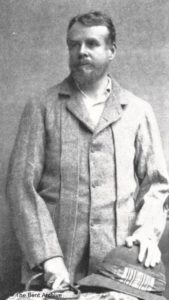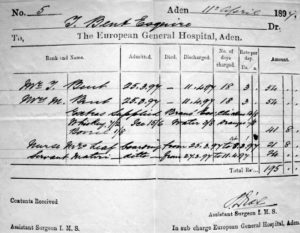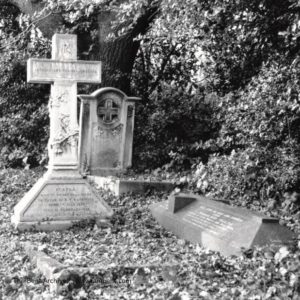Death of a noted Baildonian – Theodore Bent, 5 May 1897

Theodore Bent died on this day (5 May) in 1897. The adventurer was susceptible to malarial infections ever since his visit to Andros in the Cyclades in 1884. The diary of his wife Mabel, his permanent travel companion, records this initial event: “Wednesday [12 March 1884, Gavrio, Andros]. I did not go to bed or undress last night. I had no bed to go to and T’s temperature was a little over 104. I rolled myself up in my fur cloak and screwed myself up on the corner of the bed and would have been more comfortable if there had been no fleas. The doctor came last night and this morning. He says it is from cold. I don’t know what it is… The doctor, who constantly strolled in and screamed at T, is only an old man with some knowledge of herbs. He wanted to give T kina and was not at all satisfied that quinine was the same thing.” [The Chronicles of Mabel Bent, Vol. 1, 50-51, Archaeopress 2006]

This predisposition did not prevent Bent from risking his health in dangerous conditions in the Levant, Africa and the Middle East for the next 13 years, until, on his last explorations, he and Mabel found themselves malaria victims and stretcher-cases east of Aden in the spring of 1897.
The Bents’ travel companion on their final trip, Ernest Bennett, gives an early warning of trouble ahead: “One of our party [Theodore] had no less than four attacks of [malarial] fever during two months; and even if we escaped actual fever, we invariably experienced… a miserable feeling of lassitude and debility”. (‘Two Months in Sokotra’, Longman’s Magazine. v. 30 (May-Oct. 1897), p.408.
Mabel’s book Southern Arabia (1900) has the full, and very sad story. Thanks to their long-term Anafiote dragoman, Matthew Simos, the couple were taken by boat back to Aden, where they recovered somewhat in the infirmary there (their hospital bill has outlasted them both).
After a few weeks they were fit enough to travel, and an unnamed steamer took them via Suez to Marseilles. It seems that southern France disagreed with Theodore and his malarial symptoms returned. Alarmed, Mable rushed with her patient by train and ferry to their London home, where he died a few days later on 5 May 1897. On Theodore’s death certificate, Dr A. Elliot M.D. registered that the cause of death was “Malaria 6 weeks, Pneumonia 5 days”. The recurrence of fever as the predominant symptom tends to suggest that Theodore’s illness on his final tour was more likely to have been malaria rather than other diseases such as pneumonia or dysentery, although it would be consistent with other infections such as typhoid: there would seem to be no reason to question the diagnosis.

His early death (he was just 45) prompted eulogies in America and Europe, such was his reputation as a cavalier explorer and archaeologist. His many achievements can be seen via this link. It seems appropriate to quote from (among dozens of obituaries) the following from his local newspaper, The Shipley Times of Saturday, 15 May 1897 (the town of Shipley is a few miles from Bradford and Baildon, where Theodore grew up; the paper also misinform us of Bent’s place of birth incidentally):
“Death of a noted Baildonian – The death recently took place at his house in Great Cumberland Place, London, of Mr Theodore Bent, the well-known traveller and archaeologist. He was the only son of the late Mr James Bent, of Baildon, and was born in 1852 in the house at Low Baildon now occupied by Mr Smith Feather. Mr Bent was educated at Malvern Wells, Repton School, and Wadham College, Oxford, where he took his honours in the history school. After his marriage, in 1877, to Mabel, daughter of the late Mr Robert Westley Hall-Dare, D.L., of Newtonbarry House, County Wexford, and Wennington House, Essex, he, with his energetic and accomplished wife, spent several months each year in exploring little known districts and sites, from which he never failed to reap a rich harvest of geographical and archaeological knowledge. Mr Bent was an excellent linguist; he spoke modern Greek like a native. One of his earliest visits was to the Republic of San-Marino, on which he wrote an interesting little volume. He travelled extensively in Greece and Asia Minor, and in 1885 published a volume on “The Cyclades; or life among the Insular Greeks”. He afterwards visited the Bahrein Islands, on which he contributed a paper to the Royal Geographical Society. Perhaps he is best known by his investigations of the Zimbabwe ruins in Mashonaland, which he and Mrs Bent visited in 1891. The narrative of this interesting expedition has gone through several editions. In 1893 they visited Abyssinia, and made some valuable investigations among the ruined cities of that country. The last and fatal visit was the third visit to Southern Arabia, where Mr Bent succeeded in adding considerably to our knowledge of the Hadramut country. In 1895-96 the western shores of the Red Sea and the north of Suakim was the scene of Mr and Mrs Bent’s explorations, and here amongst the coast some remarkable remains of old Roman gold workings were discovered. Thus year after year Mr Bent continued to do good work for archaeology and geography, and he has at last fallen a martyr to his zeal. Mr Bent’s death will be a great shock to a wide circle of friends, to whom his kindly, genial, unaffected disposition had greatly endeared him. He was a Fellow of the Society of Antiquaries and of the Royal Geographical Society; of the latter he had been a member of Council. On October 11th, 1894, Mr Bent delivered a lecture to the members of the Bradford Philosophical Society on his travels in Arabia.”

Mabel was devastated by the loss, and her own full potential as an explorer and photographer was never to materialise; she died in 1929. The couple are buried together in the Hall-Dare (Mabel’s Essex and Irish family) plot in St Mary’s, Theydon Bois. Go visit, take some flowers.
 Leave a comment or contact us about this article
Leave a comment or contact us about this article